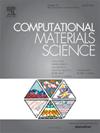Optical image analysis of WSe2 − thresholding for layer detection
IF 3.1
3区 材料科学
Q2 MATERIALS SCIENCE, MULTIDISCIPLINARY
引用次数: 0
Abstract
The fast and reliable layer identification of two-dimensional transition metal dichalcogenide (TMD), such as WSe2, is essential to investigating their thickness-dependent electronic and optical properties. This article presents efficient optical image thresholding methodology designed to segment the mono, bi, and tri-layer regions of WSe2 flakes mechanically exfoliated onto a SiO2/Si substrate. The optical images were first preprocessed to exclude the background effect and analyzed using the pixel medians and interquartile ranges for fundamental color channels—red, green, and blue (RGB). The analysis of red channel pixel intensities yielded three distinct ranges, serving as thresholds for layer segmentation: monolayer (111.0–118.0), bilayer (103.0–110.0), and tri-layer (93.0–103.0). Similarly, thresholds were established for each color channel, facilitating a comparative study of the segmentation performances. The intersection-over-union () calculations revealed that the red and green channels demonstrated greater than 99 % and 90 % accuracy in differentiating each layer, respectively. This approach yields remarkable results without substantial data calibration that utilizes time-intensive heuristic techniques. Moreover, the proposed methodology offers the flexibility to compare performances across different color channels, expanding the applicability for other 2D material systems.

用于层检测的WSe2−阈值光学图像分析
二维过渡金属二硫化物(TMD)(如WSe2)的快速和可靠的层识别对于研究其厚度相关的电子和光学性质至关重要。本文提出了一种有效的光学图像阈值分割方法,用于分割机械剥离到SiO2/Si衬底上的WSe2薄片的单层、双层和三层区域。首先对光学图像进行预处理以排除背景影响,并使用基本颜色通道红、绿、蓝(RGB)的像素中位数和四分位数范围进行分析。对红色通道像素强度的分析产生了三个不同的范围,作为层分割的阈值:单层(111.0-118.0),双层(103.0-110.0)和三层(93.0-103.0)。同样,为每个颜色通道建立阈值,便于对分割性能进行比较研究。交叉-超联合(IoU)计算显示,红色通道和绿色通道在区分每层的准确率分别大于99%和90%。这种方法产生了显著的结果,而不需要大量的数据校准,利用时间密集的启发式技术。此外,所提出的方法提供了跨不同颜色通道比较性能的灵活性,扩大了其他2D材料系统的适用性。
本文章由计算机程序翻译,如有差异,请以英文原文为准。
求助全文
约1分钟内获得全文
求助全文
来源期刊

Computational Materials Science
工程技术-材料科学:综合
CiteScore
6.50
自引率
6.10%
发文量
665
审稿时长
26 days
期刊介绍:
The goal of Computational Materials Science is to report on results that provide new or unique insights into, or significantly expand our understanding of, the properties of materials or phenomena associated with their design, synthesis, processing, characterization, and utilization. To be relevant to the journal, the results should be applied or applicable to specific material systems that are discussed within the submission.
 求助内容:
求助内容: 应助结果提醒方式:
应助结果提醒方式:


